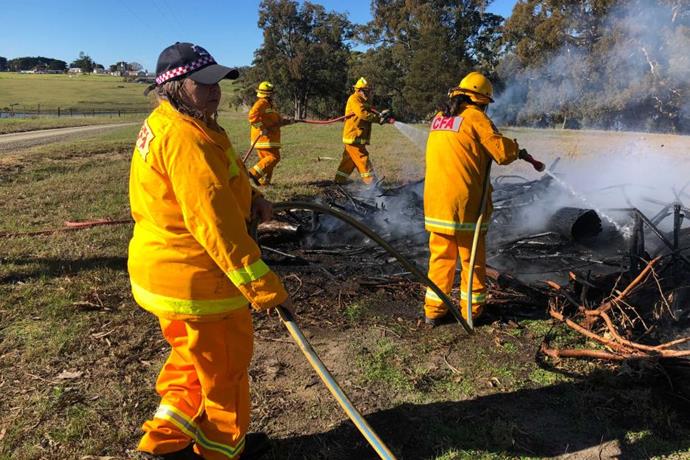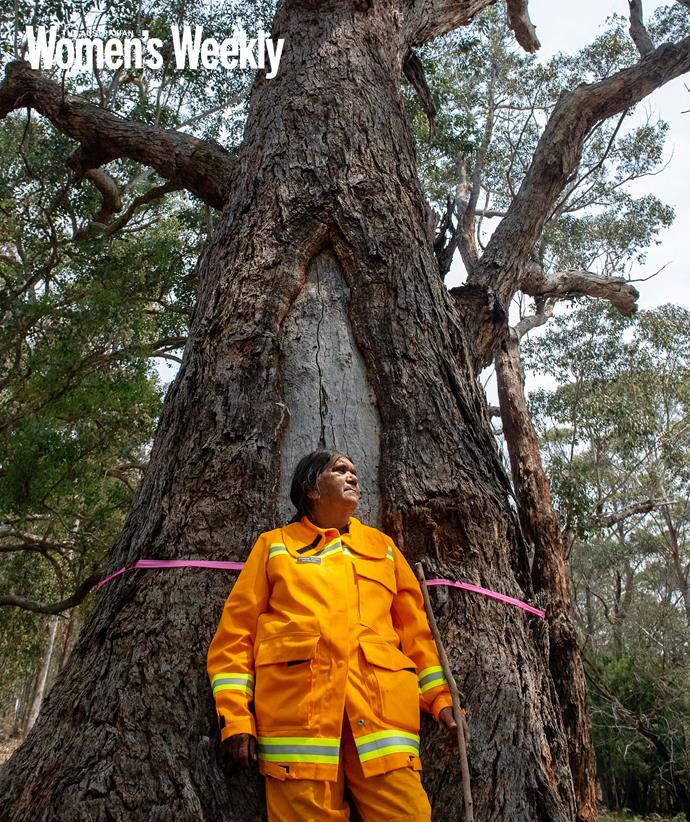4JAN20
NSW and Victoria firefighters, residents brace for night of battling damaging fires | ABC News
AUSTRALIA is battling an ecological disaster of unfathomable proportions. It is impossible to comprehend the scale of land burned, wildlife killed, the loss of property and the tragic loss of human life. The victims of the past two wildfire seasons in California probably can empathize best with the losses, fears, and anxieties Australians are experiencing. Times like these also bring out the best in people too, like Charmaine Sellings and Rhonda Thorpe of the Lake Tyers Aboriginal Trust, Victoria, Australia. From Now To Love.....Meet the all-female Indigenous fire crew protecting community, family and sacred land
In a tinder-dry continent, during the most dangerous fire season on record, Sue Smethurst meets the all-female Indigenous fire crew that fighting to protect family, community and sacred land.
Charmaine Sellings keeps a close eye on inky clouds rolling around the horizon.
"Just one crack of lightning on a stormy day could be disastrous," she says, looking across brittle paddocks sweeping up to the edge of the parched forest surrounding her community's 5000-hectare home.
Like so many parts of Australia, picturesque Lake Tyers in eastern Victoria has suffered crippling drought in recent years, and as a consequence there'll be no summer break for Charmaine or the Country Fire Authority Brigade she leads.
Instead, they'll be on-call, keeping watch over this tinder-box patch of sacred land.
"Things are pretty desperate," Charmaine says, "we are in extreme conditions, our dams are empty and it's not a good situation.
"The crew will work around the clock. We hope for a quiet summer but we fear the worst."
Charmaine's crew is Australia's first all-Indigenous, all-female fire brigade, a highly-skilled bunch of mothers and grandmothers who can pull a strike-team together faster than wildfire.
These trailblazing women are the backbone of the remote Lake Tyers Aboriginal Trust, a self-governing Aboriginal community in the State's far east.
"It's not that men aren't welcome – in fact we'd love the fellas to join us and help out!" Charmaine quips.
"Every now and then a fella comes along but they don't seem to last too long. I don't think they like taking orders from me," laughs the vivacious 52-year-old grandmother of three.
With only one access road in and out of the isolated peninsula, which is hemmed in by thick bush on one side and a vast lake system on the other, the station's 200 residents, who are among the most vulnerable in Australia, rely on these fearless fireys to keep them safe.

"We are the lifeline if anything goes wrong, so we have an important role to play, and I think people are generally very grateful for what we do," Charmaine says.
"There was a sense of helplessness before we came along but we feel empowered that we can look after ourselves and our people whatever the situation. The community is proud of us and they value us."
The Lake Tyers Aboriginal Trust CFA as it is officially known was born almost two decades ago after a spate of deliberately lit fires threatened the tiny township.
During one blaze, a home was burned to the ground. Knowing the nearest fire crew was a potentially disastrous 45-minute-drive away, Charmaine and her friends Rhonda Thorpe and Marjorie Proctor took matters into their own hands, asking the CFA to train them up to protect the culturally significant land.

They walked the streets of the settlement knocking on doors, signing up volunteers. Eight women made up the inaugural brigade.
For these unique fireys, the brigade is about much more than just protecting the community – it is also about protecting their story.
"There's 'scatters' (clusters of artefacts) all through this bush," says Charmaine, as she shows us an area just a short walk from her home where 179 artefacts were found.
The proud Kurnai woman then points to scarred trees, towering eucalypts with visible wounds from where bark was stripped hundreds of years ago to make canoes, shields or infant carriers.
She also tells of middens where tribes gathered to eat and various other sacred sites such as a women's water hole and the Burnt Bridge reserve, a 'bush-pantry' of indigenous food and medicinal plants.
This rich landscape is Gunaikurnai country, also home to dozens of significant sites that tell a story of the troubled history of the local Aboriginal community.
In 1863, after decades of conflict between white settlers and the Kurnai people, the Church of England commandeered the picturesque peninsula and established a colony known as the Lake Tyers Aboriginal Mission.
Aboriginal people from all over Victoria were forcibly removed from their homelands and brought to the mission. One of these stolen children was Charmaine's great-grandfather, who was taken from his family home near Healesville.
"He never understood why he was taken – no one ever told him," she says. "He was only a little boy, ripped away from his family."
Bitter conflict ensued at the mission until 1971, when the Victorian Government handed the title deeds back to the community, which was the first successful Aboriginal land rights claim in Australian history.
"There's a lot of history here. We still have some troubles – grog and unemployment particularly – and discrimination," she says.
Charmaine too has battled demons. The mother of two daughters and now grandmother of three has had her share of "unhealthy" relationships and personal struggles, but she has emerged stronger.

"It hasn't been an easy life," she says simply, not wanting to dwell on the past. "We've all had our challenges, made mistakes. Looking back doesn't do any good."
Women have been actively involved in fire services in Australia for more than a century, and in fact, the 'Armidale Amazons' who were operating in NSW in 1901 are believed to be the first all-women brigade in the world.
But it is still rare to find all-women crews, let alone all-Indigenous crews. The Lake Tyers women are so unusual that earlier this year they caught the attention of Hollywood TV host Ellen De Generes who sent a producer out to meet with them and hear their stories.
Today they have a core team of four women, with the odd one or two popping in and out when they can, and they have recently welcomed a 'fella', Julien "Tiny" Edwards.

"We let Tiny join!" Charmaine jokes. "Nah, he's terrific, he works hard. Every now and then a husband might join because he feels like he's missing out on something, but otherwise it's always been the women running it."
"When we first set up the brigade the men called us the Banana Women because of our bright yellow outfits," she laughs. "We had a giggle about it because they were a bit jealous of us, but the name stuck and that's what we call ourselves today."
When the brigade first began, neither Charmaine nor Rhonda, 59, could have predicted that they'd be piloting complex fire trucks, wielding chainsaws, clearing bush tracks and fighting some of Victoria's worst bushfires.
The co-captains have built a rock-solid and highly regarded team who've been called out to fires, road accidents and emergencies all over Victoria.

"We fought the Black Saturday bushfires, fires in Wilsons Promontory and Omeo. We've attended so many call-outs I've lost count," says Charmaine.
"Road accidents are always hard, terrible. You never get used to the things you see in those situations, but you do develop great resilience."
Twenty years on, Charmaine and Rhonda are actively trying to recruit the next generation to learn the ways of the land and care for the sacred country around Lake Tyers.
"The first time I picked up a chainsaw, I was terrified," Charmaine says.
"I had to cut through trees that had fallen and clear tracks so we could get through. I hated it. Now I love it. I can grab the chainsaw and clear a scene or a track in no time at all."
Rhonda says they're involvement in the brigade has given them important life skills too.
"It's given us enjoyment, friendship, a great sense of camaraderie among the women and independence."
"Positive self-esteem and confidence too," Charmaine adds, "and it's taught us how to work together, not just within our own community but the wider community too.
We've met so many new people and developed leadership skills, ways of communicating to one another, and we've learnt how to deal with stressful and difficult situations – without throwing a tantrum!" Charmaine grins.
"It's serious business, but we have a laugh too and we've built lifelong friendships."
In addition to running the Lake Tyers brigade, Charmaine travels around Victoria educating other fireys about how to recognise culturally significant sites when they are on patrol, and she is passionate about sharing the "blackfellas' ways" of traditional land and fire management.
"We all need to work together to deal with the threat of fire. Traditional blackfella ways are very effective. We need to share all our knowledge of managing the bush – white man's ways and black man's ways. We have a lot to learn from one another," she says.

With drought and climate change fuelling a terrible fire season that began in spring, the brigade has taken delivery of a new state-of-the art tanker.
Wrapped in a unique traditional artwork titled 'Working Together' which was created by Charmaine's daughter Lorraine and artist Emma Bamblett, the vehicle also serves a much greater purpose.
With its striking red, blue and purple exterior, the brigade and the CFA hope it will promote a sense of inclusion and pride, and help communicate the story of the Lake Tyers CFA, wherever it travels.

Almost as predictable as the arrival of every summer fire season, is Charmaine's annual threat to retire. Being on call day and night takes its toll, especially as she is also the full-time carer for an elderly Aunt.
She gets particularly exasperated when she sees illegal campers lighting campfires at sacred waterholes around the lake.
It means that Charmaine and Rhonda will spend every day of the summer patrolling the dozens of bush-tracks that weave through the beautiful state park.
Day and night, they will be talking to campers about fire safety and sadly often putting out fires still smouldering long after travellers have packed up and gone home.
"I can't count the number of times we've come across campfires still going when people have gone into town to get supplies or gone up the lake fishing. It makes me very angry," she says.
Still, despite her threats, Charmaine can't imagine hanging up her bright yellow overalls yet.
"I keep saying I'm going to retire, but I never get around to it," she laughs, "I can't imagine not doing it. This is our lives – it is part of who we are – it's part of me now. They'll bury me in my yellows!"

No comments:
Post a Comment